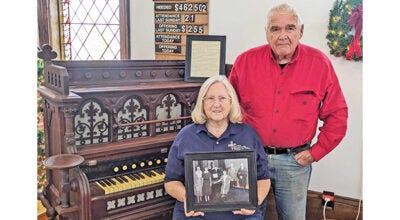Studebaker Museum recognizes milestone year
Published 10:13 am Thursday, December 26, 2013

The Studebaker Museum, located at 201 Chapin St. in Souh Bend, features countless pieces of memorabilia from the Studebaker plant, which closed 50 years ago this year. Leader photo/JILL McCAUGHAN
When it comes to the history of car manufacturing in America, many people may think first of Detroit, Mich. However, Indiana has also seen its share of innovative automobile manufacturers, with as many as 80 cities claiming a place in that history.
South Bend is one such city. As the home of the ever-evolving Studebaker Corporation from 1852 until 1963, South Bend provides Michiana residents with a manageable day trip into a bygone era with the Studebaker National Museum.
“Anybody and everybody who is interested in vehicles and transportation would enjoy visiting the Studebaker National Museum,” said Andy Beckman, archivist at the museum.
“When you visit the museum, you can really see how innovative Studebaker and other car manufacturers were,” said Jo McCoy, director of marketing, development and special projects at the museum. “Things we take for granted now, like windshield wipers, those were things that weren’t standard equipment in the past.”
The innovations to which McCoy referred are presented in an exhibit entitled “Something New Under the Sun: Automotive Inventions and Innovations,” which runs through Jan. 26, 2014. From it, visitors can learn about advances that include safety glass, air conditioning and the automatic transmission.
However, the history of the Studebaker Corporation long predates the advent of the auto, and visitors to the museum will find that story told by the numerous exhibits.
Located within the Center for History at 201 S. Chapin St. since 2005, the Studebaker National Museum takes visitors on a journey that begins with the roots of the Studebaker Company as a blacksmith shop founded by two brothers, Henry and Clement.
The brothers expanded into building horse-drawn wagons and buggies, eventually becoming the world’s largest manufacturers of those vehicles. Several of them are on display as a part of the “Presidential Carriage Collection,” including ones that they built for Ulysses S. Grant and Benjamin Harrison.
Because the Studebaker brothers had an appreciation for history themselves, they were responsible for acquiring many of the earliest artifacts that are now on display at the museum.
Consequently, visitors to the museum can view several historically significant carriages that were purchased by the brothers, including the barouche that carried President Lincoln to Ford’s Theater on the evening of his assassination.
Guests who are interested in the transition from the horse-drawn to the horseless carriage will find that evolution displayed throughout the three levels of the museum.
The Studebaker National Museum has approximately 70 gleaming vehicles on display at any given time, including a historic police car, fire engine and hearse. However, on the lowest level, visitors can view more cars in what Beckman calls “visible storage.”
Studebaker’s ties to historical figures were not severed when they moved into automobile production with an electric model in 1902. In fact, Thomas Edison purchased the second electric car that Studebaker ever produced.
Within only two years, the company had moved into production of gasoline-powered automobiles, a segment of the company that was based for two decades in Detroit, Mich.
South Bend became the home of automobile production for Studebaker in the 1920s, where it continued until the plant closed in 1963. The museum offers visitors the opportunity to view up-close the very last car that was made by Studebaker in South Bend, an Italian-styled sports car called the Avanti.
“They were on the ropes. The Avanti was a last-ditch effort to try to interest the public in their product. It was just too late,” Beckman explained. “They just weren’t able to compete with the Big Three — Ford, General Motors and Chrysler.”
Having been a central component of the manufacturing scene in South Bend, the closing of the Studebaker plant on Dec. 20th, 1963 was devastating for the city.
Commemorating the 50th anniversary of the plant’s closing, the museum currently features “Studebaker: Preserving the Past…Pursuing the Future.” Spanning more than 100 years of the history of the growth and development of Studebaker, the exhibit illustrates the connections between the company and the city of South Bend. It will continue on display through May 26, 2014.
“It was a huge blow to the economy, but it’s amazing how quickly South Bend recovered,” McCoy said. “A group of city leaders and captains of industry got together, and within just three years, South Bend had bounced back to its previous employment numbers. It’s an amazing story.”
More information regarding the Studebaker National Museum can be obtained on their website at www.studebakermuseum.org or by calling the museum at (574) 235-9714.





